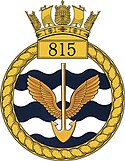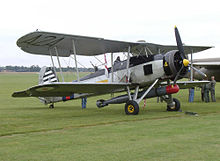815 Naval Air Squadron: Difference between revisions
Foxhound66 (talk | contribs) →On the Westland Lynx: update |
m Sqn moved back in 1998-99 not 1995 and is no longer the worlds largest helo Sqn. But the rankings are difficult to determine as it depends on the definition of a Sqn, it is certainly one of the largest due to its composition of HQ and Flights. |
||
| Line 56: | Line 56: | ||
====On the [[Westland Lynx]]==== |
====On the [[Westland Lynx]]==== |
||
[[Image:LynxHAS8 LCC-20 2005.JPEG|thumb|left|A Westland Lynx HAS.8]] |
[[Image:LynxHAS8 LCC-20 2005.JPEG|thumb|left|A Westland Lynx HAS.8]] |
||
In January 1981, after a gap of some 15 years, the squadron re-commissioned at [[RNAS Yeovilton (HMS Heron)]] with the [[Westland Lynx|Lynx HAS.2]] as the Headquarters Squadron for embarked Lynx Flights. It then moved to [[RNAS Portland (HMS Osprey)]] in 1982 and it saw action during the [[Falklands War]] of 1982. The flights were shared with [[829 Naval Air Squadron]] until they were amalgamated in 1993 when they became the largest helicopter squadron in the world.<ref name="815 hist"/> In |
In January 1981, after a gap of some 15 years, the squadron re-commissioned at [[RNAS Yeovilton (HMS Heron)]] with the [[Westland Lynx|Lynx HAS.2]] as the Headquarters Squadron for embarked Lynx Flights. It then moved to [[RNAS Portland (HMS Osprey)]] in 1982 and it saw action during the [[Falklands War]] of 1982. The flights were shared with [[829 Naval Air Squadron]] until they were amalgamated in 1993 when they became the largest helicopter squadron in the world at the time.<ref name="815 hist"/> In 1998/9 after an absence of nearly 17 years, the unit moved back to RNAS Yeovilton, with the closure of RNAS Portland. |
||
Several of the Lynx Helicopters are stated as part of the [[Response Force Task Group]].<ref>http://www.royalnavy.mod.uk/operations-and-support/operations/auriga/index.htm</ref> |
Several of the Lynx Helicopters are stated as part of the [[Response Force Task Group]].<ref>http://www.royalnavy.mod.uk/operations-and-support/operations/auriga/index.htm</ref> |
||
Revision as of 09:38, 31 May 2011
| 815 Naval Air Squadron | |
|---|---|
 Official 815 Naval Air Squadron Badge | |
| Active | Oct 1939 - Nov 1939 Nov 1939 - Jul 1943 Oct 1943 - Nov 1944 Dec 1944 - 1945 1947 - July 1958 Sep 1958 - Aug 1959 Sep 1959 - Dec 1960 Jul 1961 - Oct 1966 Jan 1981 - present |
| Country | |
| Branch | |
| Type | Naval Air Squadron |
| Role | Maritime Attack |
| Part of | Fleet Air Arm |
| Garrison/HQ | RNAS Yeovilton (HMS Heron) |
| Motto(s) | Strike Deep |
| Equipment | Westland Lynx HAS.3, HMA.8 DSP and HMA.8 SRU |
| Battle honours | North Sea 1940 Mediterranean 1940-42 Taranto 1940 Libya 1941-42 Matapan 1941 Burma 1944 East Indies 1944 Falkland Islands 1982 Kuwait 1991[1] |
| Commanders | |
| Current commander | Commander L.M. Wilson-Chalon, RN (since 15 December 2010) |
| Ceremonial chief | HRH Queen Elizabeth II |
815 Naval Air Squadron is a squadron of the Fleet Air Arm, part of the Royal Navy. The squadron is currently based at RNAS Yeovilton (HMS Heron) in Somerset, United Kingdom and it is the Navy's front line Lynx Naval Air Squadron. It currently comprises more than 30 Lynx helicopters of various types. It is the largest helicopter squadron in western Europe.[2]
History
World War II


The squadron initially formed at RNAS Worthy Down on 9 October 1939, from the remnants of 811 and 822 squadrons that had survived the sinking of their carrier HMS Courageous in September 1939,[3] with Fairey Swordfish aircraft. The squadron disbanded in November 1939, but reformed the same month however.[3] In May 1940 the squadron provided support to the Dunkirk evacuation.[3] In June 1940 the squadron embarked on HMS Illustrious and sailed for the Mediterranean in August, attacking and minelaying Benghazi, Rhodes and Tobruk.[3] The squadron gained early fame with its involvement in the Battle of Taranto in 1940. The battle consisted of a raid on the Italian Battlefleet in harbour at Taranto which redefined the use of air power from the sea. During the battle only one squadron aircraft was lost (unfortunately with the Squadrons Commanding Officer),[3] compared to the crippling of half the Italian Fleet. In March 1941, the squadron was once again involved in a major battle of the Second World War at the Battle of Cape Matapan; a battle that ensured the Italian Fleet did not leave harbour until the end of the war. The squadron re-equipped in August 1941 with a mixture of Swordfish and Fairey Albacore aircraft, operating from shore bases in support of the North African campaign.[3] In July 1943, 815 Squadron was assigned to No. 201 (Naval Co-operation) Group with a detachment of Swordfish assigned to AHQ Malta. Both units participated in Operation Husky on 10 July 1943, before 815 Squadron was disbanded.
On Fairey Barracudas

The squadron reformed in October 1943 at RNAS Lee-on-Solent (HMS Daedalus) to operate Fairey Barracuda torpedo bombers, operating from Indomitable with the Eastern Fleet, flying airstrikes over Sumatra in August–September 1944.[4] It disbanded once again in November 1944 before reforming in December 1944 at RNAS Machrihanish (HMS Landrail), flying Barracudas for anti-submarine operations, the following month being spent doing DLT (deck landing training) on HMS Campania.[3] The squadron then was transferred to the Far East aboard HMS Smiter, but saw no action before VJ-Day, and returned to the UK in September 1945 aboard HMS Fencer.[3]
Post Second World War
Flying Avengers and Gannets


The squadron disbanded some time after the war and reformed in 1947 from 744 Squadron, flying Grumman Avengers, who were replced in their turn with Fairey Gannets the last fixed-wing aircraft of the Squadron when it disbanded at RNAS Culdrose (HMS Seahawk), July 1958.[5]
Enter the Whirlwind

In September 1958 the squadron reformed and the first helicopters arrived in the form of the Westland Whirlwind HAS.7, moving to RNAS Portland (HMS Osprey) when engine troubles sterted to plague the Whirlwinds. The squadron eventually disbanded here on August 1959, by being renumbered to 737 Squadron.[5]
The squadron reformed again on 8 September 1959, still on with Whirlwinds. After a Far East tour on HMS Albion, it disbanded again in December 1960.[5]
With Westland Wessexes

On 4 Jul 1961, the Squadron recommissioned at RNAS Culdrose with the Westland Wessex HAS.1.[6] The squadron embarked on HMS Ark Royal in November 1961, moving to HMS Centaur in 1964 and provided support against disturbances in Aden and in Tanganyika (now Tanzania). After a final deployment on HMS Ark Royal, the unit disbanded at RNAS Culdrose in October 1966.[5]
On the Westland Lynx

In January 1981, after a gap of some 15 years, the squadron re-commissioned at RNAS Yeovilton (HMS Heron) with the Lynx HAS.2 as the Headquarters Squadron for embarked Lynx Flights. It then moved to RNAS Portland (HMS Osprey) in 1982 and it saw action during the Falklands War of 1982. The flights were shared with 829 Naval Air Squadron until they were amalgamated in 1993 when they became the largest helicopter squadron in the world at the time.[6] In 1998/9 after an absence of nearly 17 years, the unit moved back to RNAS Yeovilton, with the closure of RNAS Portland.
Several of the Lynx Helicopters are stated as part of the Response Force Task Group.[7]
Current composition
The squadron is currently composed of a Headquarters and 26 Small Ship's Flights. The Headquarters are responsible for the maintenance and doctrine for the aircraft. The Small Ship's Flights operate from the Type 22 and Type 23 frigates, and Type 42 Destroyers. These Flights are then embarked on ships around the world, including two on HMS Endurance.[2]
Aircraft flown

Currently, the squadron only flies the Westland Lynx HMA.8. A list of aircraft that have been flown by 815 Naval Air Squadron in the past include:[4][1]
- Fairey Swordfish Mks.I, II
- Fairey Albacore Mk.I
- Fairey Fulmar Mks.I, II
- Fairey Barracuda Mk.II, TR3
- Grumman Wildcat Mk.VI
- Fairey Firefly T
- Grumman Avenger TBM-3E, AS4, AS5
- Fairey Gannet AS1, T2, AS4
- Westland Whirlwind HAR3, HAS7
- Westland Wessex HAS.1
- Westland Lynx HAS2, HAS3
References
- Notes
- ^ a b "SQUADRONS OF THE FLEET AIR ARM 2009". www.fleetairarmoa.org. The Fleet Air Arm Officers' Association. Retrieved 2 April 2011.
- ^ a b "815 -- Introduction". www.royalnavy.mod.uk. Royal Navy. Retrieved 26 March 2009.
- ^ a b c d e f g h "815 Squadron". www.fleetairarmarchive.net. Fleet Air Arm Archive. Retrieved 12 August 2007.
- ^ a b c d "815 Squadron Fleet Air Arm, 1939 to present". www.helis.com. Retrieved 2 April 2011.
- ^ a b "815: History". www.royalnavy.mod.uk. Royal Navy. Retrieved 26 March 2009.
- ^ http://www.royalnavy.mod.uk/operations-and-support/operations/auriga/index.htm
- Bibliography
- Thetford, Owen (1994). British Naval Aircraft since 1912 (4 ed.). London: Putnam. ISBN 0-85177-861-5.
{{cite book}}: Cite has empty unknown parameter:|coauthor=(help) - Sturtivant, Ray (1994). The Squadrons of the Fleet Air Arm (2 ed.). Tonbridge, Kent, UK: Air Britain (Historians) Ltd. ISBN 0-85130-223-8.
{{cite book}}: Unknown parameter|coauthor=ignored (|author=suggested) (help)
